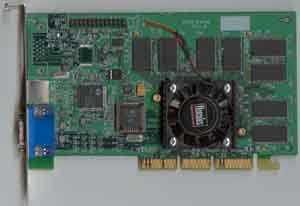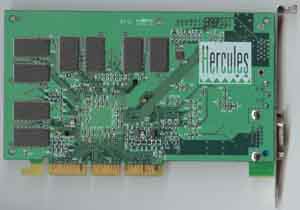
Original Link: https://www.anandtech.com/show/305
| Once a strong force in the industry, a series of defeated products in this competitive marketplace has put Hercules at a position where they must go above and beyond their competitors in order to hang on to what market share they have left. Their faith in the Savage3D part from S3 last year proved, in the end, to be another addition to a frightening list of failed products. With the aid of NVIDIA's Riva TNT chipset, their Dynamite TNT accelerator turned out to be a hit, relatively speaking in comparison to their last product, the Savage3D based Terminator Beast. |  |
| Although Hercules has another S3 based product in their lineup this time around they aren't relying on S3 to generate the sales they'll be looking for to make an entry back into the eyes of the users, that duty is once again put on NVIDIA with their TNT2 chip. | |
The first TNT2 based accelerators have finally hit the streets, and although they aren't the best accelerators money can buy, the rest are on the way. Among those that fall into the "on-the-way" category is Hercules' Dynamite TNT2 Ultra board, what is soon to be their flagship product as soon as it hits the streets in the coming few weeks. The original Dynamite TNT was an overclocker's choice, and shadowed the competition in terms of performance, driver quality, and gave more meaning to the Hercules brand name. Unfortunately, with the TNT2, things are much more complicated in the market. The market for TNT2 accelerators is a unique one and with all of the different clock speeds available as well as all of the different card manufacturers, it can be very difficult to pick out the card that's right for you. It's Hercules' job to make sure that the card that's right for you is the Dynamite TNT2 Ultra, as it is Diamond's job to make sure that the card that's right for you is the V770. How do you decide between the two? Well, it's AnandTech's job to make sure you get the card that's right for you, bar none. Let's get to the Hercules Dynamite TNT2 Ultra.
Card Specifications
- NVIDIA RIVA TNT2 (Ultra) graphics and multimedia processor
- AGP 2x/AGP 4x ready
- 128-bit TwiN Texel Engine, delivering single cycle multi-texturing
- Up to 32MB of high performance memory
- 32-bit true color 3D rendering
- 32-bit Z/Stencil buffer
- Resolutions up to 1920x1440
- 300 MHz DAC
2D Display Modes |
|||
Resolution |
Colors |
Vertical Refresh Rate |
Monitor Scan Range |
| 1920x1200 | 16.7M 65,536 256 |
60 60-75 60-75 |
90 90-113 90-113 |
1920x1080 |
16.7M 65,536 256 |
60-72 60-85 60-85 |
84-100 84-118 84-118 |
1600x1200 |
16.7M 65,536 256 |
60-75 60-85 60-85 |
75-94 75-106 75-106 |
1280x1024 |
16.7M 65,536 256 |
60-100 60-120 60-120 |
64-109 64-131 64-131 |
1152x864 |
16.7M 65,536 256 |
60-140 60-150 60-150 |
51-126 54-136 54-136 |
1024x768 |
16.7M 65,536 256 |
60-170 60-170 60-170 |
48.3-138 48.3-138 48.3-138 |
800x600 |
16.7M 65,536 256 |
60-240 60-240 60-240 |
37.9-154 37.9-154 37.9-154 |
640x480 |
16.7M 65,536 256 |
60-240 60-240 60-240 |
31.5-126 31.5-126 31.5-126 |
1 DVD playback
requires a software DVD player; not included with all models.
2TV-out included on Dynamite TNT2 Ultra models only.
The Card
| The Hercules Dynamite TNT2 Ultra is built upon a somewhat sloppily laid out reference design PCB. The 32MB Ultra board is available with TV-Out for $16 more, as well as bundled with a software DVD decoder for $20 in addition to the $229.99 base price of the card. What do you get for $229.99? |
The Dynamite TNT2 Ultra, as the name implies is based on an "Ultra" version of the TNT2 chipset, which according to NVIDIA, indicates that the core clock speed and the memory clock speed should be no less than 150MHz and 183MHz respectively. While the 150/183MHz clock configuration is considerably higher than the 90/110MHz configuration of the original TNT, it still doesn't live up to the hype that benchmarks of the first pre-release TNT2 Ultra cards inspired. Regardless of the factors that went into NVIDIA's decision to lower the core clock speed from 175+ down to 150MHz, the bottom line is that had manufacturers stuck to NVIDIA's 150MHz clock speed they would've most definitely lost quite a few supporters with their inability to deliver a more competitive product.
So instead of NVIDIA risking the humiliation of supplying chips shabbily rated at frequencies greater than 150MHz, they put the final decision in the hands of the board manufacturers. If the board manufacturers were willing to take the heat (no pun intended) on a part that doesn't work at a frequency greater than the 150MHz specification, then they can go right ahead and do it. Consider this a form of indirect encouragement for overclocking from NVIDIA, they know it can be done, and they know just how far their chips can overclock. However as with overclocking CPUs, there's always a risk that your processor won't work at the new speed, and that's a risk NVIDIA's not willing to take. If a user wants a faster TNT2 part, they have two options, try and overclock their 150MHz Ultra part to something higher, or seek out a manufacturer that's willing to rate their chips at a higher frequency than the 150MHz spec. The latter type of manufacturer is just the type of manufacturer Hercules happens to be. They're so confident in their Dynamite TNT2 Ultra boards that they're willing to rate them at a 175MHz core and 200MHz memory frequency, a 16% and a 9% increase over NVIDIA's rating respectively.
| This isn't the first time Hercules has made their products offer more than the competition, even with their Terminator Beast Supercharged board Hercules made sure that they got the fastest and most reliable Savage3D chips by hand picking them and putting them through a rigorous testing process. | |
| It's this dedication and work ethic that drove Hercules to announce the fastest TNT2 Ultra based product on the market, but as we've all come to know all too well, performance isn't everything, so what's the rest of the Dynamite TNT2 Ultra like? | |
| The $229.99 base price of the card isn't all profit, in fact quite a bit of it goes back into the production costs of the board. Case in point would be the high quality AAVID fan that cools the TNT2 Ultra chip when running at 175MHz. The AAVID fan is the same one found on the Matrox G400MAX, which is kept cool while operating at a beefy 166MHz frequency. At the time of questioning Hercules would not disclose the other memory manufacturer that would be supplying the 5.5ns parts for the Dynamite TNT2 Ultra boards, however AnandTech's test sample made use of Hyundai's 5.5ns SDRAM. | 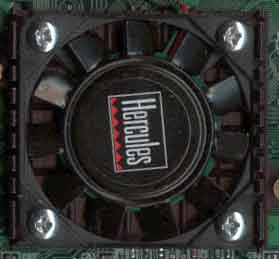 |
| The SDRAM is organized in two groups of eight 2MB (8 on each side) SDRAM chips placed on the front and back of the PCB. The front of the PCB is shared with the Brooktree 869 TV-out controller chip, the same chip used on all reference design TNT2's with TV-out support. | |
The back panel of the Dynamite TNT2 Ultra is home to the VGA output connector as well as the S-Video connector. Interestingly enough Hercules made a last minute change to remove the LCD output port from the rear of the board, most likely to keep the costs of the Dynamite TNT2 Ultra from rising much higher than the already pricey $229.99 mark.
Hercules' didn't supply AnandTech with the driver/utility CD that comes bundled with every Dynamite TNT2 Ultra, however we will be taking a look at and evaluating their bundled utilities shortly. Included with the Dynamite TNT2 Ultra is the much talked about Hercumeter overclocking utility that provides the ability to overclock the core/memory frequencies of the Dynamite TNT2 Ultra using two slider bars. How far can the Dynamite TNT2 Ultra be pushed? In AnandTech's tests, the Dynamite TNT2 Ultra made it up to 195MHz core, and 230MHz memory. After a few hours the 195/230 settings eventually crashed, however dropping the core down to 190MHz seemed to stabilize things by a noticeable margin. The sweet spot will most likely be 190/220 on most boards, however the success of your overclocking attempts will vary depending on the yield of the TNT2, memory parts, and the PCB itself.
Although there is no guarantee when overclocking, honestly speaking from one computer user to another, Hercules guarantees their cards at 175/200, that means that regardless of what card you get, it'll work at a core clock speed 16% faster than what NVIDIA states the TNT2 Ultra should be clocked at. There is a very good chance that you'll be able to hit at least 190/200, and since the memory generally doesn't vary as much from chip to chip, 190/220 and maybe even 190/230 won't be too far out of your reach. Hercules doesn't have the luxury of simply releasing a product and having the world see it on their shelves, they need to offer potential customers something that will tempt them away from the oh-so-familiar Diamond and Creative boxes, a very difficult task at that. Hopefully, for Hercules' sake, the sheer performance of the Dynamite TNT2 Ultra will do just that.
The 2D image quality of the Dynamite TNT2 is fine at resolutions up to 1280 x 1024, unfortunately at 1600 x 1200 the image quality takes a noticeable dive. Although it is noticeably better than the best of TNT cards in terms of 2D image quality, the Dynamite TNT2, as well as most TNT2 based cards aren't too friendly on your eyes at 1600 x 1200 and above. If you're really looking for a combination of a professional/gaming card then Matrox's G400/G400MAX is probably what you should be setting your sights on, unfortunately getting one of those hot items is easier said than done.
The Test
The card was compared to the 3dfx Voodoo3 2000/3000, Leadtek Winfast 3D S320-II 16MB TNT2, and the Diamond Stealth III S540 32MB Savage4 cards. AnandTech's Slot-1/Socket-370 test configuration was as follows:
- Intel Pentium III 500 (high-end), Intel Pentium II 266 (low-end) on an ABIT BX6 Revision 2.0
- 64MB of Memman/Mushkin SEC Original SDRAM was used in each test system
- Western Digital 5.1GB Ultra ATA/33 HDD
- Microsoft Windows 98 w/ DirectX 6.1
AnandTech's Super7 test configuration differed only in the processor/motherboard used
- AMD K6-3 400
- FIC PA-2013 (1MB) w/ VIA AGP Drivers v3.3
The benchmark software used was as follows:
- id Software's Quake 2 Version 3.20 using demo1.dm2 and 3Finger's crusher.dm2 & the AMD 3DNow! patch where applicable
- 3DMark99 was used to compare performance between cards based on the same chipset
Each benchmark was run a total of three times and the average frame rates taken. Vsync was disabled
All scores were taken at a 16-bit color depth and 16-bit Z-buffer unless otherwise stated
AnandTech used Matrox Millennium G400 DualHead driver revision 4.11.01.1100; AnandTech used NVIDIA Riva TNT2 Ultra driver revision 0181 with 3DNow! support for all of the TNT2 tests.
For more TNT2 benchmarks, visit AnandTech's full NVIDIA Riva TNT2 Review
OpenGL Performance
Quake 2 is on its way out as a benchmark, but concluding its reign with a bang is the Dynamite TNT2 Ultra at the overclocked 195/220MHz setting as it dominates the high-end system scores at 1024 x 768. The Dynamite TNT2 Ultra benchmarked flawlessly at all speeds, unfortunately, even the 195/220MHz monster takes a back seat to the Matrox G400 in terms of performance when rendering in 32-bit color. Do keep in mind that the high performing G400MAX still has yet to hit the streets and when it does (most likely in July) it will come with a not-so-friendly $250+ price tag.
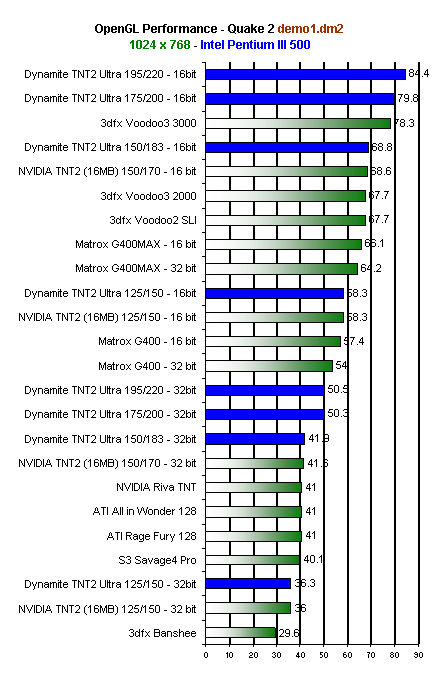
There's no major change in the crusher arena, the Dynamite TNT2 Ultra at 195/220 still dominates the charts. The 16MB Leadtek TNT2 moves up slightly simply due to more aggressive memory timings on the Leadtek card, which is clocked at a much lower frequency by default than Hercules' solution. At 200MHz, Hercules was essentially required to use slower memory timings to ensure stability during normal operation - hope I didn't give away Hercules' little secret ;)
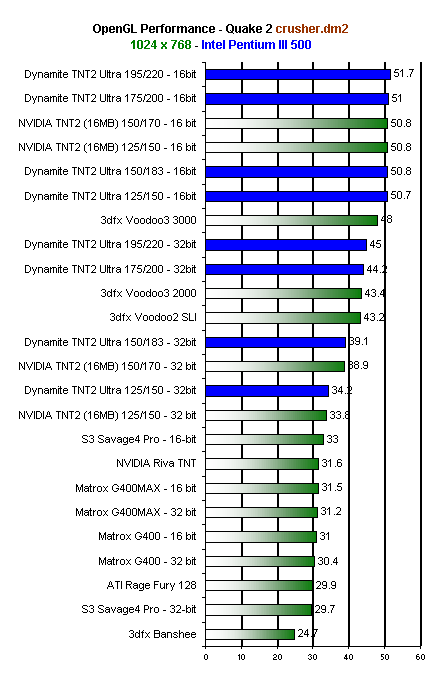
As you can tell by the Chip Speed Scalability graphs, there is a noticeable improvement (10 fps) in the jump from NVIDIA's recommended 150/183MHz setting and the default 175/200MHz setting of the Dynamite TNT2 Ultra. The jump from 175/200 to 195/220 isn't as dramatic, but if it'll work for you go ahead and give it a try, if it doesn't, 175/200 isn't bad at all. The key point to remember here is that Hercules is guaranteeing the Dynamite TNT2 Ultra at 175/200, something no other manufacturer has done as of yet, meaning that you can expect 175/200 performance out of the box without having to worry about whether or not your card will overclock to that speed.
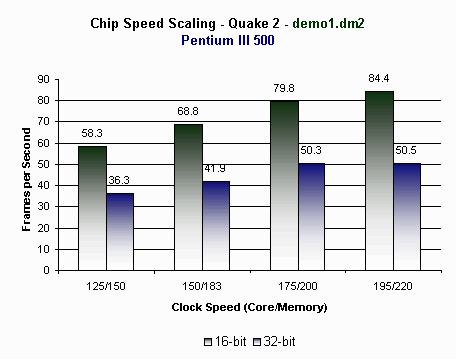
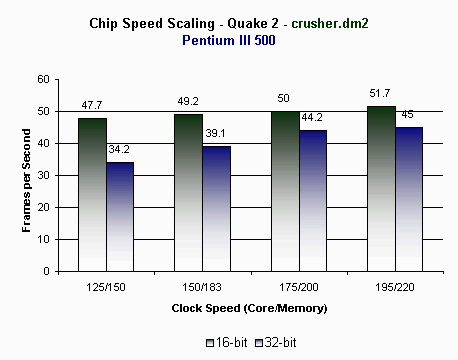
As you'd expect, 3dfx takes the lead on the slower systems as the TNT2 is much more CPU dependent than the Voodoo3/2. The 195/220 TNT2 Ultra isn't too far behind, followed closely by its unoverclocked brother, and the rest of the NVIDIA clan. Here you get into a battle of CPU dependency, the Voodoo3 isn't as CPU dependent as NVIDIA's TNT2 Ultra, but the TNT2 Ultra isn't as CPU dependent as Matrox's G400/G400MAX. So you end up with the TNT2 Ultra as a better option, even for 32-bit rendering than Matrox's G400MAX. Oh how things can change with the flip of a processor...
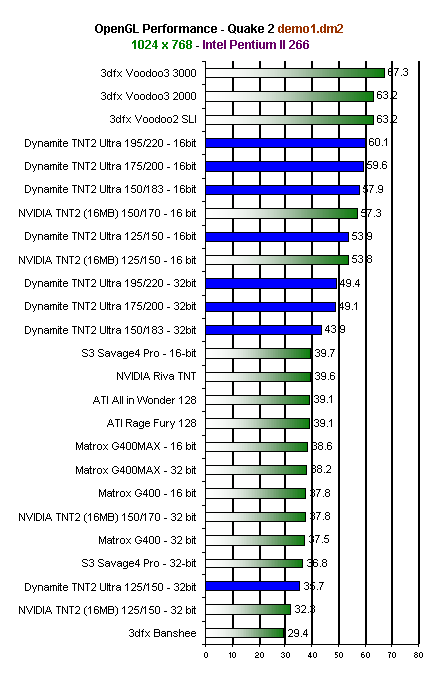

With a CPU slower than a Pentium II 350, there is absolutely no point to the increased clock speeds the Dynamite TNT2 Ultra offers. You're better off buying a cheaper 150/183MHz solution or if you're willing to take a small drop in performance, a non-Ultra TNT2 will do you just fine. You're better off putting some extra money into a faster processor (Celeron 366's aren't too expensive) and getting a non-Ultra TNT2 than spending a lot of money on the Dynamite TNT2 Ultra and not really gaining any benefit. If you're planning to upgrade your CPU in the near future however, then the Dynamite TNT2 Ultra isn't as bad of a choice as it will scale quite nicely with your processor.

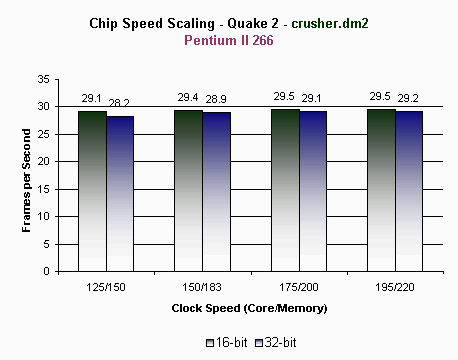
Here's the killer, AnandTech had tremendous problems with the Super7 platform and the first TNT2 board reviewed here. It turns out that ALi doesn't have the best chipset platform in terms of Super7 compatibility, as was first proven by the compatibility problems between the Savage4 and the Aladdin V chipset. The TNT2 exhibited similar behavior when put in an Aladdin V board, however the opposite seems to be true with the VIA MVP3 chipset using VIA's latest AGP drivers (3.3). Although the installation and setup of the Hercules Dynamite TNT2 was still a bit more painful on AnandTech's Super7 test bed than on the Slot-1 test bed, after installing the latest AGP drivers, the bus mastering drivers, the IRQ routing driver, the PCI bridge patch, the NVIDIA TNT2 Ultra drivers and finally the AGP drivers again, in that order, the test bed came to life. NVIDIA's latest build of TNT2 drivers, that will hopefully become available to the public within the next week or so, contain vastly improved 3DNow! enhancements in the code, the results? Well, see for yourself, here is just a glimpse of what AnandTech has been working on in the lab, a full fledged video comparison as well as a K6-3 revisited article are in the works at AnandTech with some extremely pleasing results for all you Super7 users out there.
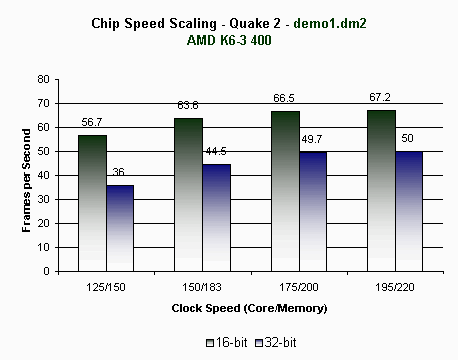
Here's something interesting, at the default clock speed of 175/200MHz, the Dynamite TNT2 Ultra on the AMD K6-3 400 is 16% slower than on the Pentium III 500 which has a 25% clock speed advantage over the K6-3 400. Interesting... AnandTech is currently working on a full investigation of current performance of the K6-3 and K6-2 processors and will be publishing results as well as a quick guide in the next week, here are some more teasers to tide you over until then ;)
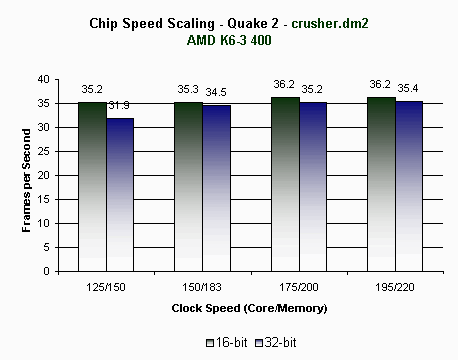
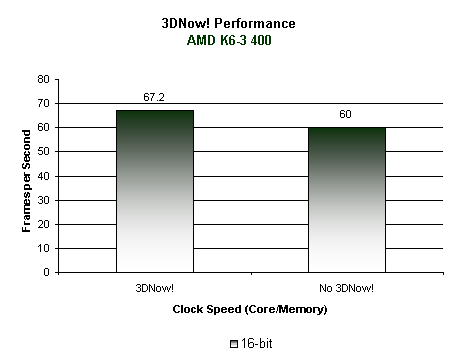
Direct3D Performance
Although 3DMark isn't representative of actual gameplay, it is an excellent tool for comparing similar cards to one another. As you can see, when the CPU isn't the bottleneck, as is the case with the Pentium II 500, the increase in core/memory clock speed of the Dynamite TNT2 Ultra is visible primarily in an increase in the Fill Rate of the processor. Where this comes in handy is at higher resolutions, although it won't make 1600 x 1200 playable, it does make resolutions like 1280 x 1024 possible without cringing too much.
3DMark99 - Intel Pentium III 500 |
|||||||||
| 16-bit Rendering | 32-bit Rendering |
||||||||
125/150 |
150/175 |
175/200 |
195/220 |
125/150 |
150/175 |
175/200 |
195/220 |
Core/Mem |
|
Rasterizer Score |
1827 |
2158 |
2478 |
2672 |
1380 |
1636 |
1889 |
1938 |
3DRasterMarks |
Game 1 - Race |
51 |
56 |
56 |
56 |
33 |
39 |
45 |
45 |
FPS |
Game 2 - First Person |
47 |
47 |
47 |
47 |
42 |
45 |
47 |
47 |
FPS |
Fill Rate |
201 |
238 |
273 |
294 |
108 |
127 |
147 |
148 |
MTexels/s |
Fill Rate With Multi-Texturing |
192 |
229 |
264 |
290 |
174 |
207 |
239 |
249 |
MTexels/s |
2MB Texture Rendering Speed |
199 |
229 |
257 |
258 |
125 |
147 |
169 |
169 |
FPS |
4MB Texture Rendering Speed |
147 |
169 |
190 |
191 |
97 |
114 |
131 |
132 |
FPS |
8MB Texture Rendering Speed |
94 |
108 |
121 |
122 |
75 |
88 |
101 |
102 |
FPS |
16MB Texture Rendering Speed |
60 |
70 |
78 |
80 |
51 |
60 |
70 |
70 |
FPS |
3DMark99 - Intel Pentium II 266 |
|||||||||
| 16-bit Rendering | 32-bit Rendering |
||||||||
125/150 |
150/175 |
175/200 |
195/220 |
125/150 |
150/175 |
175/200 |
195/220 |
Core/Mem |
|
Rasterizer Score |
1723 | 2021 |
2253 |
2480 |
1328 |
1560 |
1777 |
1838 |
3DRasterMarks |
Game 1 - Race |
23 |
23 |
23 |
23 |
23 |
23 |
23 |
23 |
FPS |
Game 2 - First Person |
24 |
24 |
24 |
24 |
24 |
24 |
24 |
24 |
FPS |
Fill Rate |
190 |
223 |
248 |
272 |
104 |
123 |
141 |
142 |
MTexels/s |
Fill Rate With Multi-Texturing |
185 |
218 |
218 |
244 |
168 |
198 |
225 |
237 |
MTexels/s |
2MB Texture Rendering Speed |
175 |
200 |
223 |
223 |
118 |
137 |
155 |
156 |
FPS |
4MB Texture Rendering Speed |
130 |
148 |
164 |
165 |
92 |
106 |
121 |
121 |
FPS |
8MB Texture Rendering Speed |
83 |
94 |
105 |
106 |
71 |
82 |
93 |
94 |
FPS |
16MB Texture Rendering Speed |
54 |
61 |
67 |
68 |
49 |
56 |
65 |
65 |
FPS |
AMD's K6-3 400 stands strong, with 3DNow! support native in DirectX 6.1 and the latest NVIDIA 0181 drivers which also boast 3DNow! support behind the processor, the K6-3 400 is on the heels of the Pentium III 500 in terms of fill rate, however the weak FPU of the K6-3 400 keeps it below the Pentium II 500 in terms of actual gameplay in the two Game tests.
3DMark99 - AMD K6-3 400 |
|||||||||
| 16-bit Rendering | 32-bit Rendering |
||||||||
125/150 |
150/175 |
175/200 |
195/220 |
125/150 |
150/175 |
175/200 |
195/220 |
Core/Mem |
|
Rasterizer Score |
1844 | 2192 |
2192 |
2726 |
1392 |
1700 |
1700 |
1961 |
3DRasterMarks |
Game 1 - Race |
37 |
37 |
37 |
37 |
32 |
35 |
35 |
35 |
FPS |
Game 2 - First Person |
27 |
28 |
28 |
28 |
27 |
27 |
27 |
27 |
FPS |
Fill Rate |
205 |
244 |
244 |
305 |
109 |
135 |
135 |
150 |
MTexels/s |
Fill Rate With Multi-Texturing |
195 |
233 |
233 |
298 |
177 |
215 |
215 |
254 |
MTexels/s |
2MB Texture Rendering Speed |
195 |
232 |
232 |
255 |
125 |
153 |
153 |
169 |
FPS |
4MB Texture Rendering Speed |
142 |
167 |
167 |
184 |
96 |
118 |
118 |
130 |
FPS |
8MB Texture Rendering Speed |
90 |
106 |
106 |
116 |
74 |
89 |
89 |
99 |
FPS |
16MB Texture Rendering Speed |
56 |
65 |
65 |
71 |
50 |
60 |
60 |
67 |
FPS |
Final Words
The Hercules Dynamite TNT2 Ultra is the fastest TNT2 accelerator on the market, and has the greatest potential. It is perfect for users with CPU's faster than a Pentium II 350, and for once, that isn't exclusively for Intel owners. Super7 owners will enjoy the same performance benefits from the TNT, including the Dynamite TNT2 Ultra as soon as NVIDIA publicly releases their latest 3DNow! drivers which should be shortly in the next week or so. Until they do in fact release the drivers Super7 users should stand idle before shelling out the cash for the Dynamite TNT2 Ultra or any TNT2 accelerator for that matter, as soon as the drivers hit though, go out and enjoy the benefits.
The only areas the Dynamite TNT2 Ultra is lacking in are with it's high price, $229.99 is considerably higher than what you're probably used to paying for. Remember all the Voodoo2 users that spent $300 on a single card? Imagine how they feel now than a single Voodoo2 is less than $100, if you don't mind feeling that way in a couple months, then purchasing the Dynamite TNT2 Ultra should be done with no regrets, otherwise there's no pain in waiting. If the price is too high, and you still want the best in performance, 3dfx seems to be the only other option available. The Voodoo3 isn't a terrible accelerator, although it is sometimes made out to be due to its lack of 32-bit rendering support. The Voodoo3 isn't a card that will keep your bragging privileges at the height of their career as soon as you bag the card, but it is a card that will give you the performance you're looking for, at a more affordable price than the $229.99 Dynamite TNT2 Ultra is setting you back.
Of course, there is a third option, primarily, going for another TNT2 manufacturer, however if you want the fastest, the Dynamite TNT2 Ultra is probably your best bet. It gets the AnandTech seal of approval.

